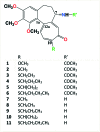7-Deacetyl-10-alkylthiocolchicine derivatives - new compounds with potent anticancer and fungicidal activity
- PMID: 30429975
- PMCID: PMC6195099
- DOI: 10.1039/c8md00352a
7-Deacetyl-10-alkylthiocolchicine derivatives - new compounds with potent anticancer and fungicidal activity
Abstract
A series of new semi-synthetic 7-deacetyl-10-alkylthiocolchicne derivatives with ethyl, n-propyl, i-propyl and n-butyl substituents were synthesised and characterised by spectroscopic methods, elemental analysis, DFT calculations and molecular docking simulations. All the synthesized compounds have been tested for fungicidal and anticancer activities against SKOV-3, LoVo, MCF-7, MDA-MB-231 and the lung-derived fibroblast CCD39Lu. All the new colchicine derivatives exhibit significantly higher cytotoxicity towards the SKOV-3 tumour cell line than the natural product - colchicine. The most effective cytotoxic agents were 7-deacetyl-10-n-buthylthiocolchicine and 7-deacetyl-10-i-propylthiocolchicine. Among all the compounds tested, 7-deacetyl-10-n-buthylthiocolchicine exhibited the highest fungicidal activity. Molecular modeling indicated that several mutations found in the β-tubulin unit of the tested fungal strains are crucial for antifungal activity and selectivity of 7-deacetyl-10-n-buthylthiocolchicine. The obtained results may be useful for the development of selective colchicine derivatives as effective fungicidal and/or anticancer drugs.
Figures



Similar articles
-
Synthesis, anticancer activity and molecular docking studies of N-deacetylthiocolchicine and 4-iodo-N-deacetylthiocolchicine derivatives.Bioorg Med Chem. 2021 Feb 15;32:116014. doi: 10.1016/j.bmc.2021.116014. Epub 2021 Jan 11. Bioorg Med Chem. 2021. PMID: 33465696
-
Synthesis, antiproliferative activity and molecular docking of thiocolchicine urethanes.Bioorg Chem. 2018 Dec;81:553-566. doi: 10.1016/j.bioorg.2018.09.004. Epub 2018 Sep 12. Bioorg Chem. 2018. PMID: 30248507
-
Synthesis, antiproliferative activity and molecular docking of Colchicine derivatives.Bioorg Chem. 2016 Feb;64:103-12. doi: 10.1016/j.bioorg.2016.01.002. Epub 2016 Jan 12. Bioorg Chem. 2016. PMID: 26794327
-
Novel benzothiazole-based dual VEGFR-2/EGFR inhibitors targeting breast and liver cancers: Synthesis, cytotoxic activity, QSAR and molecular docking studies.Bioorg Med Chem Lett. 2022 Feb 15;58:128529. doi: 10.1016/j.bmcl.2022.128529. Epub 2022 Jan 7. Bioorg Med Chem Lett. 2022. PMID: 35007724 Review.
-
Antifungal carbazoles.Curr Med Chem. 2009;16(17):2205-11. doi: 10.2174/092986709788612701. Curr Med Chem. 2009. PMID: 19519387 Review.
Cited by
-
B-nor-methylene Colchicinoid PT-100 Selectively Induces Apoptosis in Multidrug-Resistant Human Cancer Cells via an Intrinsic Pathway in a Caspase-Independent Manner.ACS Omega. 2022 Jan 11;7(3):2591-2603. doi: 10.1021/acsomega.1c04659. eCollection 2022 Jan 25. ACS Omega. 2022. PMID: 35097257 Free PMC article.
-
Discovery and development of botanical natural products and their analogues as therapeutics for ovarian cancer.Nat Prod Rep. 2023 Jul 19;40(7):1250-1270. doi: 10.1039/d2np00091a. Nat Prod Rep. 2023. PMID: 37387219 Free PMC article. Review.
-
Tissue Extract from Brittle Star Undergoing Arm Regeneration Promotes Wound Healing in Rat.Mar Drugs. 2023 Jun 28;21(7):381. doi: 10.3390/md21070381. Mar Drugs. 2023. PMID: 37504912 Free PMC article.
-
Cytotoxic, analgesic and anti-inflammatory activity of colchicine and its C-10 sulfur containing derivatives.Sci Rep. 2021 Apr 27;11(1):9034. doi: 10.1038/s41598-021-88260-1. Sci Rep. 2021. PMID: 33907227 Free PMC article.
-
Colchicine, Caffeine, Gramine, and Their Derivatives as Potential Herbicides, Fungicides, and Insecticides.Int J Mol Sci. 2024 Sep 19;25(18):10081. doi: 10.3390/ijms251810081. Int J Mol Sci. 2024. PMID: 39337565 Free PMC article.
References
-
- Boyé O. and Brossi A., The Alkaloids, Chemistry and pharmacology, ed. A. Brossi and G. A. Cordell, Academic Press, New York, 1992, vol. 41, pp. 125–176.
-
- Brossi A. J. Med. Chem. 1990;33:2311–2314. - PubMed
-
- Zhang S. H., Feng J., Kuo S. C., Brossi A., Hamel E., Tropsha A., Lee K. H. J. Med. Chem. 2000;43:167–176. - PubMed
LinkOut - more resources
Full Text Sources
Miscellaneous

